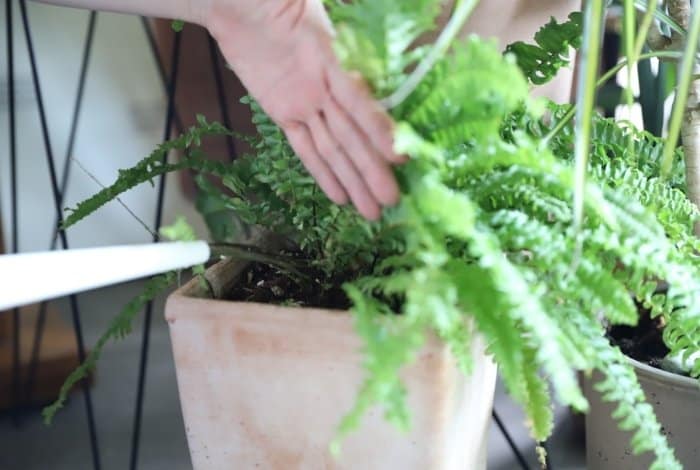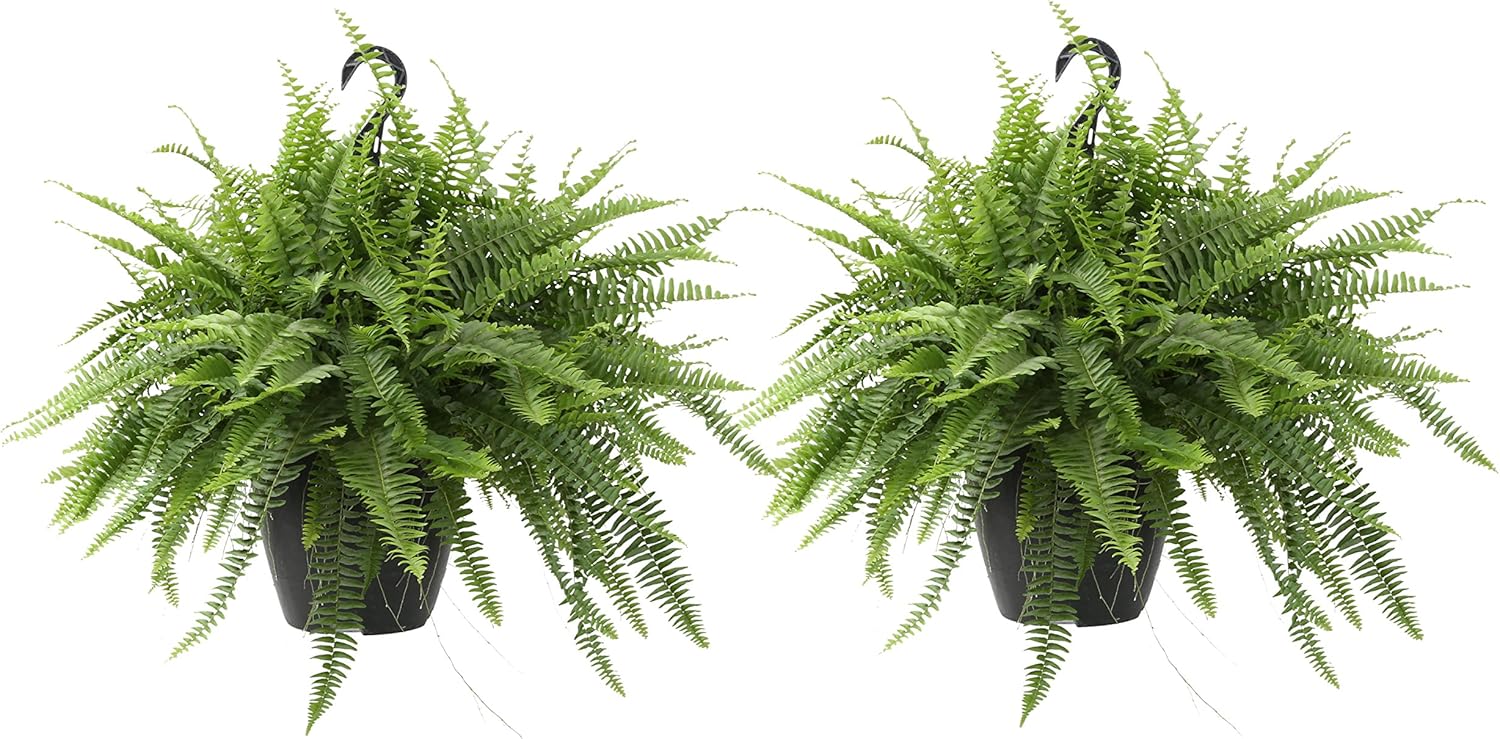Last Updated on January 17, 2022 by
If you are wondering how to undertake the care of Boston fern outdoors, this article will help you with clear guidelines that you can follow.
Ferns always soften up the look of a room. Their lacy appearance works well for any home bringing a formal natural theme. Boston fern is an old fashioned lush plant that is loved for its lacy, bright green foliage. It is possible to grow this plant both indoors and outdoors. This fern produces attractive fronds that arch gracefully for an outstanding view. Compared to other types of ferns, this type offers gardeners good growth. It requires easy maintenance during the summer and spring seasons.
Can You Grow Boston Fern Outside?
Boston fern is known to grow indoors as a houseplant. It thrives outdoors as well in warm humid climates of USDA zones 9-11. This type of fern when grown outdoors requires adequate moisture
Frost kills Boston fern completely leaving it looking dead but in spring it grows back again. Boston fern thrives in partial to full shade or filtered light. This makes the plant a good choice for damp or shady areas and provides a spark of bright color when it grows.
Costa Farms Premium Live Boston Fern Hanging Basket
Boston fern prefers rich organic soils. Use compost, mulch, or finely chopped bark to enrich your soil for better fern growth.
These ferns are perfect for the front porch. They thrive in areas that have indirect sunlight. The morning sun is ideal but full afternoon sun can burn off the fronds.
Boston ferns thrive in the subtropical areas of Florida. They make an attractive mid-height ground cover with dapples shade.
A Guideline To Care Boston Fern Outdoors
With ultimate care, Boston fern will thrive outdoors. Here is the Boston fern care that you can use to grow them outdoors.
Soil: Boston ferns prefer light, loamy and airy soils. You can add compost to your potting mix for best results. Add perlite and peat moss to the soil to improve airflow to the roots. These also ensure proper drainage after watering. Your soil should have a proper balance of the soil amendments without using too much of anything.
Watering: Boston fern is drought tolerant thus it requires plenty of water. Always provide adequate water to keep your soil moist not too much or too little. Do not allow the soil to become too soggy by overwatering because this will kill the fern. If you live in a dry climate, make it a habit to mist the plant lightly on hot days. If you are growing your fern in a container, it will need watering daily in the summer season.
Fertilizing: Use small amounts of fertilizer because the Boston fern is a light feeder. If the leaves turn pale or yellowish, it is an indication that the plant is lacking enough nutrients. Feed the fern frequently throughout its growing season. Use a dilute mixture of water-soluble fertilizer or provide a slow-release fertilizer in spring.
Pest control: Boston ferns are pest-resistant but are susceptible to damage by slugs. If you notice a light slug infestation, pick the pests off the plant early in the moving or late evening. Drop them in a bucket of soapy water to eliminate them. You can also use other non-toxic methods to discourage pests. For example, sprinkle dry eggshells or dry coffee grounds, or non-toxic slug pellets around the slug.
Temperature: Boston ferns prefer temperatures between 60-75 degrees. If you live in a region that the temperature falls under 55 degrees in the Winter, you will need to grow your ferns in pots. This is to help you move them inside to save them from frost when it starts to get cold outside. Once inside, do not place your pots near open places or vents. The cold wind blowing on them through these spaces will affect the health of your ferns.
Re-potting: The size of the pot you choose is what determines the space that the roots will have to grow. This also determines the size of your fern. If your fern is in a small pot, re-pot it when it begins to look like it will split the sides of the container. Always re-pot into a bigger pot each time to allow more growth than the previous one. If you don’t want your plant to grow larger, remove it from the pot, shake off the soil, and trim back the roots. With the right care, the fern will recover from the root pruning stress and bloom. Choose a container that has lots of drainage holes.

Learn How To Care For Ferns In Hanging Baskets
Boston Fern Outside- Conclusion
Boston ferns are a delight to grow both in and outdoors. Have you grown them? What type are you growing – the upright fronds or the arching ones? Tell us in the comments below.
FAQs
How much sunlight does a Boston fern need?
The first thing to remember when growing Boston ferns is that they are not native to the United States, but are actually from South America. This means they need much more light than the average houseplant and would do better outside. That being said, if you can't place your plant outdoors because of climate or other reasons, there are still some easy things you can do to help maximize their health and lifespan while indoors.
Boston Ferns are one of the most popular houseplants. They are easy to care for and can survive with minimal sunlight. In the Boston area, a Boston fern needs about 4-6 hours of sunlight each day. In other areas, this number will vary so it is important to ensure that there is at least one hour of direct sunlight every day.
However, if you’re in a sunnier place it needs about four hours of direct sunlight daily, so they should be placed in an east-facing window or near a south-facing window.
The roots need to be watered two to three times a week for healthy growth. The soil should not be allowed to dry out completely, but it is important that it does not stay wet for too long either. It is important that the Boston Ferns are not placed near any vents because they can dry out quickly due to hot air being blown over them 24/7.
How do you tell if fern is overwatered?
It’s important to know the signs that indicate that a fern is overwatered because it will lead to a plant that is unhealthy and will not grow.
1. Fern leaves may be yellowing or browning on the edges, wilting, curling, or turning black.
2. The soil around the fern may be moist and wet with a slimy texture.
3. Ferns typically need to be watered once every 3-5 days depending on how much light they receive and how warm it is in your home, but overwatering can lead to yellowing of leaves and soggy roots if you water too frequently.
4. Ferns planted in pots should have drainage holes so that water doesn’t pool at the base
Can Boston ferns be kept outside?
Boston ferns are one of the most popular houseplants and they can be kept outside in summer. They can be kept outside as they do not need a lot of water and light. Boston ferns are one of the most popular plants in households as they need little care. They have been grown outdoors for decades now and have been known to survive winters outdoors.
They can be kept outside, but they need to be protected from extreme temperature changes and strong sunlight.
Boston ferns prefer to live in a well-lit area with a lot of water, like a garden or porch. When kept outside, they need to be protected from the sun and strong winds. It is best to move them into a shadier area or under a tree.
They need a lot of sun and water, but make sure to avoid getting any water on the fronds because this can cause them to rot.
Caroline is a gardener who loves to get down to the nitty–gritty of gardening. She proudly proclaims herself as a ‘dirt worshipper‘ and can often be found deep in the garden, covered in soil and singing to her plants. As a self–proclaimed ‘plant whisperer‘, Caroline believes that plants need love and attention just like any other living thing, and she loves to give them both. When she‘s not tending to her garden, you can often find her researching the latest gardening trends, or teaching others how to make their gardens thrive



